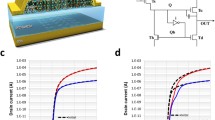Abstract
An understanding of dielectric breakdown mechanisms is critical for continued oxide scaling. Although working transistors have been demonstrated with sub-2nm SiO2 gate dielectrics, the manufacturability of such devices hinges on the reliability of the oxide. As oxides become thinner and operating voltages become lower, a fundamentally different mode of dielectric breakdown occurs. This has been called soft breakdown and is considered to be the formation of a small, localized tunneling path through a dielectric. For transistors with 2-nm gate oxides, threshold voltage and maximum transconductance are not affected by soft breakdown, implying that circuits may continue to operate after soft breakdown. The increase in gate current or voltage noise associated with soft breakdown is not a limiting factor for many applications. However, some cases will be shown in which soft breakdown does degrade device function.
In order to make comparisons of ultra-thin oxide quality, it is important to be able to reliably detect soft breakdown. J-ramp, a commonly used ramped-current measurement to determine oxide quality, is unable to detect soft breakdown in ultra-thin oxides. We will demonstrate the incorporation of noise measurements in a commercial J-ramp algorithm.
Similar content being viewed by others
References
D. R. Volters and J. F. Verwey, “Breakdown and Wearout Phenomena in SiO2 Films,” Chap. 6 p. 329, in Instabilities in Silicon Devices. G. M. Barbottin and A. Vapaille Eds., 1986 Elsevier Science Publishers.
K. R. Farmer, R. Saletti, and R. A. Buhrman, Applied Physics Letters Vol. 52, 1988, pp. 1749–1751.
M. Depas, T. Nigam, and M. M. Heyns, IEEE TED, Vol. 43, No.9, p. 1499, 1996 and References therein.
B. E. Weir, P. J. Silverman, D. Monroe, K. S. Krisch, M. Alam, G. Alers, T. W. Sorsch, G. L. Timp, F. Baumann, C. T. Liu, Y. Ma, D. Hwang, IEDM Tech. Digest p. 73, (1997).
F. Crupi, R. Degraeve, G. Groeseneken, T. Nigam, and H. Maes, IEEE TED, Vol. 45, No.11, p. 2329, 1998.
E. Wu, E. Nowak, J. Aitken, W. Abadeer, L. K. Han, and S. Lo, IEDM Tech. Digest p. 187 (1998).
The initial voltage ranged from 5.27-5.32V in all cases except for the 0.04cm2 capacitor which ranged from 5.37-5.42V.
T. Pompl, H. Wurzer, M. Kerber, R. C. W. Wilkins, I. Eisele, IEEE IRPS Proceedings p. 82 (1999).
The stress was removed within approximately 30 seconds after the breakdown. In the constant-voltage case, breakdown increases the current and therefore the stress on the oxide, while in constant-current, breakdown decreases the voltage and therefore the stress on the oxide. An interesting experiment would be to remove the stress in a shorter time after breakdown and compare the two cases.
G. B. Alers, B. E. Weir, M. R. Frei, and D. Monroe, IEEE IRPS Proceedings p. 410 (1999).
Author information
Authors and Affiliations
Corresponding author
Rights and permissions
About this article
Cite this article
Weir, B.E., Silverman, P.J., Alers, G.B. et al. Soft Breakdown in Ultra-Thin Oxides. MRS Online Proceedings Library 567, 301–306 (1999). https://doi.org/10.1557/PROC-567-301
Published:
Issue Date:
DOI: https://doi.org/10.1557/PROC-567-301




